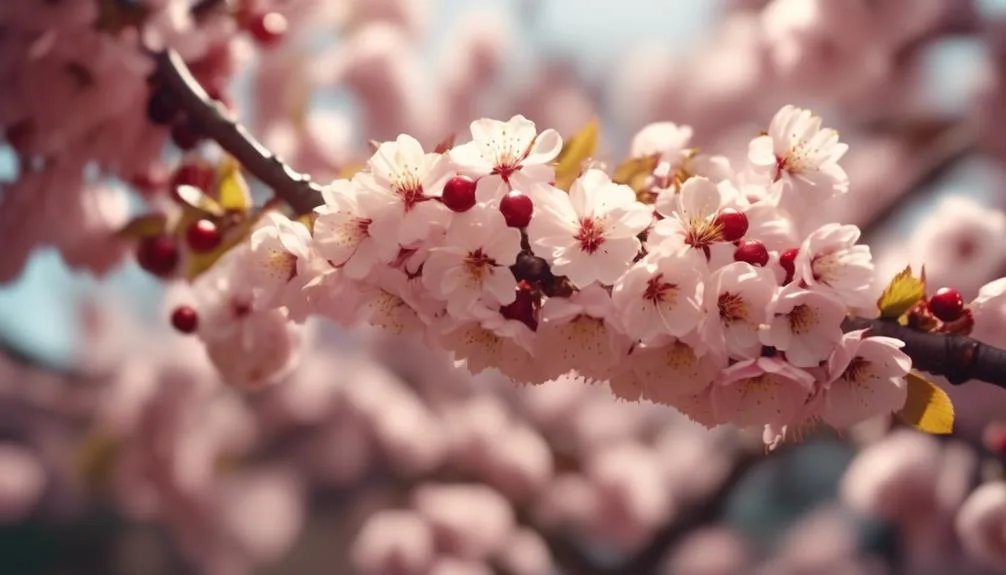Cherry trees' biennial fruiting, producing fruit every other year, is a captivating natural cycle influenced by various factors. Understanding this pattern can offer valuable insights into optimizing fruit production.
Imagine strolling through an orchard filled with the sweet scent of cherry blossoms, eagerly anticipating the bountiful harvest. But why do cherry trees seem to produce fruit only every other year? This intriguing phenomenon holds the key to unlocking the secrets of consistent yield and fruit production.
Cherry Tree Growth Cycle
As a cherry tree owner, understanding the growth cycle of your trees is crucial for maximizing fruit production and maintaining their health and vitality.
Pruning techniques play a significant role in shaping the growth and productivity of your cherry trees. Regular pruning, especially during the dormant season, helps in removing dead or diseased wood, improving air circulation, and promoting the growth of new fruiting wood.
Additionally, maintaining soil fertility is essential for ensuring the overall health and vigor of your cherry trees. Conducting soil tests and amending the soil with organic matter or appropriate fertilizers can provide the necessary nutrients for robust tree growth and abundant fruit production.
Factors Affecting Fruit Production
To maximize fruit production from your cherry trees, it's essential to consider various factors that can influence the quantity and quality of the harvest. These factors include:
- Environmental Influences: The surrounding environment, such as the presence of pollinators, air quality, and nearby vegetation, can impact fruit production. Ensuring a healthy and supportive environment for your cherry trees can positively influence their fruit yield.
- Genetic Factors: The genetic makeup of the cherry tree variety you have planted plays a significant role in determining its fruit production. Selecting high-quality, disease-resistant cultivars can contribute to better and more consistent fruit yields.
- Nutrient Availability and Weather Patterns: Adequate nutrient availability in the soil and favorable weather conditions, including appropriate moisture levels and temperature ranges, are crucial for optimal fruit production. Monitoring and managing these factors can help ensure a successful harvest.
Energy Allocation in Alternate Years
In alternate fruiting years, cherry trees allocate their energy resources differently, impacting the timing and abundance of fruit production. This biennial fruiting pattern is a result of the tree's reproductive strategy and resource management.
During the 'on' year, when the tree produces a large crop, it expends a significant amount of energy on flower and fruit development. This energy allocation leaves the tree with fewer resources for vegetative growth, resulting in smaller reserves for the following year's fruit production.
In the 'off' year, the tree conserves its energy, focusing on vegetative growth and accumulating reserves for the next fruiting cycle. This alternating pattern allows the tree to efficiently manage its resources, ensuring the sustainability of fruit production while maintaining overall health and vigor.
Hormonal Regulation of Flowering
During the biennial fruiting cycle, cherry trees regulate their flowering through a complex interplay of hormonal signals, shaping the timing and abundance of fruit production in each alternate year. The process is influenced by flowering hormones and environmental cues, which act as triggers for the initiation of flowering.
Genetic regulation also plays a crucial role, as specific genes within the cherry tree respond to seasonal changes, orchestrating the transition from vegetative growth to flower development. This intricate hormonal regulation of flowering ensures that cherry trees synchronize their reproductive efforts with optimal environmental conditions and available resources, enhancing the likelihood of successful fruit set in the following year.
For further reading, refer to the article 'Why Do Cherry Trees Produce Fruit Biennially' for a comprehensive understanding of the biennial fruiting cycle.
Practical Tips for Improving Fruit Yield
Implementing proper pruning techniques is essential for maximizing cherry tree fruit yield and quality. Pruning helps maintain tree shape, encourages fruit production, and improves sunlight penetration.
Additionally, ensuring the right soil nutrients is crucial. Conduct a soil test to determine the specific needs of your cherry trees. Adjust the soil pH and provide necessary nutrients like nitrogen, phosphorus, and potassium to support healthy growth and fruit development.
Moreover, consider pollination methods. Introducing compatible pollinators or using hand pollination can significantly enhance fruit set. Bees are excellent natural pollinators for cherry trees, so planting bee-friendly flowers nearby can attract them.
Conclusion
Understanding the natural biennial growth cycle of cherry trees sheds light on factors influencing fruit yield.
By considering energy allocation, hormonal regulation, and environmental conditions, we can support our cherry trees to thrive and bear abundant fruit in the long run.
Happy gardening!
Mark Hoffman is a dedicated arborist and tree care specialist with over a decade of experience. His love for trees began when he visited Yosemite National Park as a teenager and was awestruck by the giant sequoias. Mark pursued his passion by studying forestry at Michigan Technological University, where he earned a Bachelor of Science degree.
Since then, he has worked tirelessly in the field of arboriculture, helping to preserve and protect trees in his community. His expertise and dedication have made him a respected leader in the industry and a valuable resource for anyone seeking advice on tree care.
